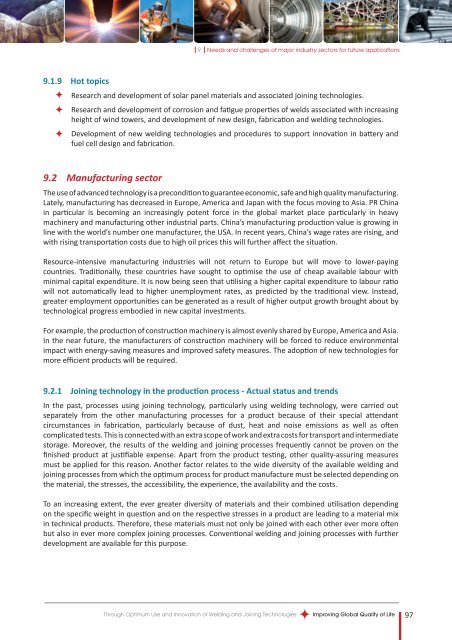Improving Global Quality of Life
Improving Global Quality of Life
Improving Global Quality of Life
Create successful ePaper yourself
Turn your PDF publications into a flip-book with our unique Google optimized e-Paper software.
9 Needs and challenges <strong>of</strong> major industry sectors for future applications<br />
9.1.9 Hot topics<br />
Research and development <strong>of</strong> solar panel materials and associated joining technologies.<br />
Research and development <strong>of</strong> corrosion and fatigue properties <strong>of</strong> welds associated with increasing<br />
height <strong>of</strong> wind towers, and development <strong>of</strong> new design, fabrication and welding technologies.<br />
Development <strong>of</strong> new welding technologies and procedures to support innovation in battery and<br />
fuel cell design and fabrication.<br />
9.2 Manufacturing sector<br />
The use <strong>of</strong> advanced technology is a precondition to guarantee economic, safe and high quality manufacturing.<br />
Lately, manufacturing has decreased in Europe, America and Japan with the focus moving to Asia. PR China<br />
in particular is becoming an increasingly potent force in the global market place particularly in heavy<br />
machinery and manufacturing other industrial parts. China’s manufacturing production value is growing in<br />
line with the world’s number one manufacturer, the USA. In recent years, China’s wage rates are rising, and<br />
with rising transportation costs due to high oil prices this will further affect the situation.<br />
Resource-intensive manufacturing industries will not return to Europe but will move to lower-paying<br />
countries. Traditionally, these countries have sought to optimise the use <strong>of</strong> cheap available labour with<br />
minimal capital expenditure. It is now being seen that utilising a higher capital expenditure to labour ratio<br />
will not automatically lead to higher unemployment rates, as predicted by the traditional view. Instead,<br />
greater employment opportunities can be generated as a result <strong>of</strong> higher output growth brought about by<br />
technological progress embodied in new capital investments.<br />
For example, the production <strong>of</strong> construction machinery is almost evenly shared by Europe, America and Asia.<br />
In the near future, the manufacturers <strong>of</strong> construction machinery will be forced to reduce environmental<br />
impact with energy-saving measures and improved safety measures. The adoption <strong>of</strong> new technologies for<br />
more efficient products will be required.<br />
9.2.1 Joining technology in the production process - Actual status and trends<br />
In the past, processes using joining technology, particularly using welding technology, were carried out<br />
separately from the other manufacturing processes for a product because <strong>of</strong> their special attendant<br />
circumstances in fabrication, particularly because <strong>of</strong> dust, heat and noise emissions as well as <strong>of</strong>ten<br />
complicated tests. This is connected with an extra scope <strong>of</strong> work and extra costs for transport and intermediate<br />
storage. Moreover, the results <strong>of</strong> the welding and joining processes frequently cannot be proven on the<br />
finished product at justifiable expense. Apart from the product testing, other quality-assuring measures<br />
must be applied for this reason. Another factor relates to the wide diversity <strong>of</strong> the available welding and<br />
joining processes from which the optimum process for product manufacture must be selected depending on<br />
the material, the stresses, the accessibility, the experience, the availability and the costs.<br />
To an increasing extent, the ever greater diversity <strong>of</strong> materials and their combined utilisation depending<br />
on the specific weight in question and on the respective stresses in a product are leading to a material mix<br />
in technical products. Therefore, these materials must not only be joined with each other ever more <strong>of</strong>ten<br />
but also in ever more complex joining processes. Conventional welding and joining processes with further<br />
development are available for this purpose.<br />
Through Optimum Use and Innovation <strong>of</strong> Welding and Joining Technologies<br />
<strong>Improving</strong> <strong>Global</strong> <strong>Quality</strong> <strong>of</strong> <strong>Life</strong><br />
97
















